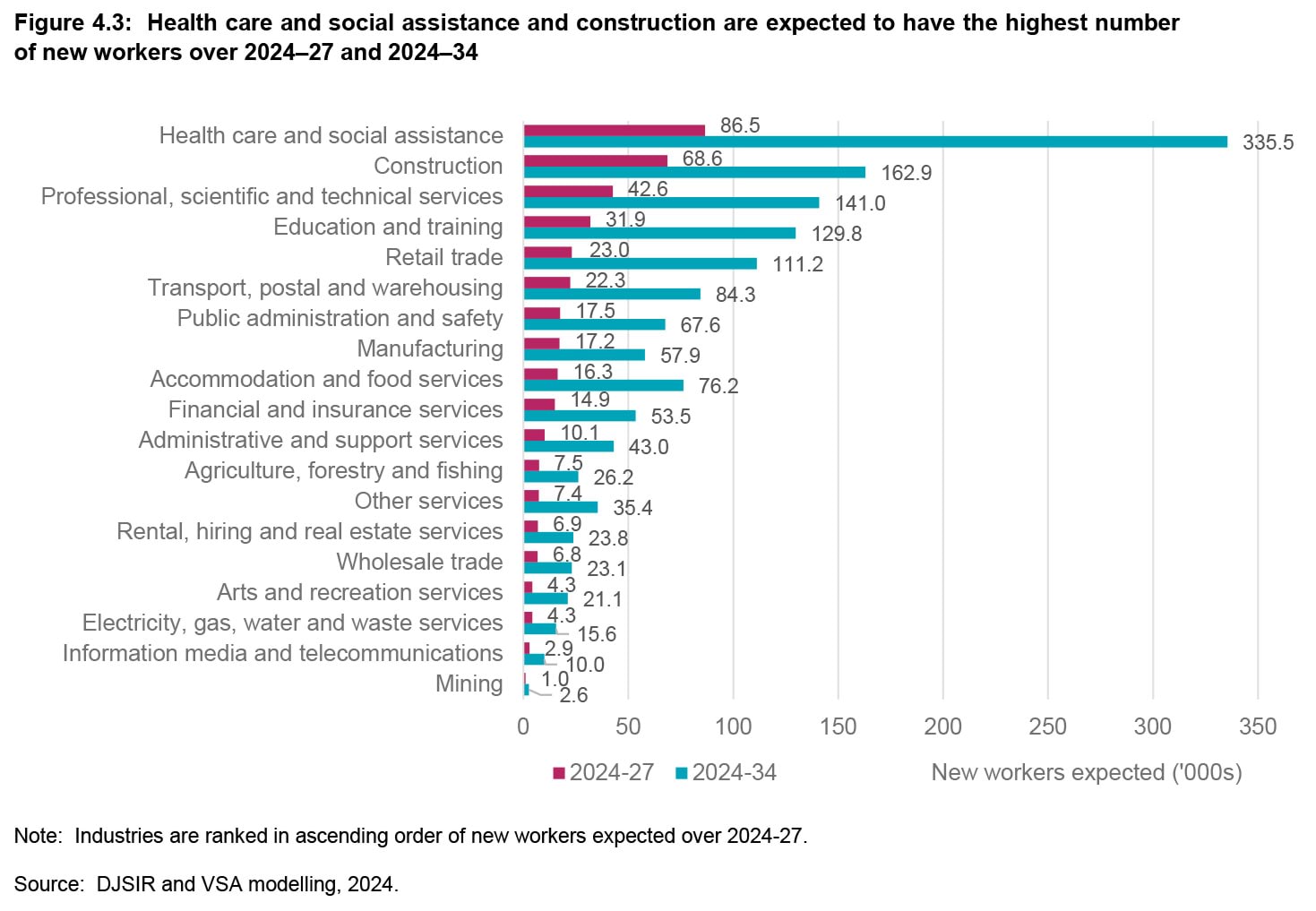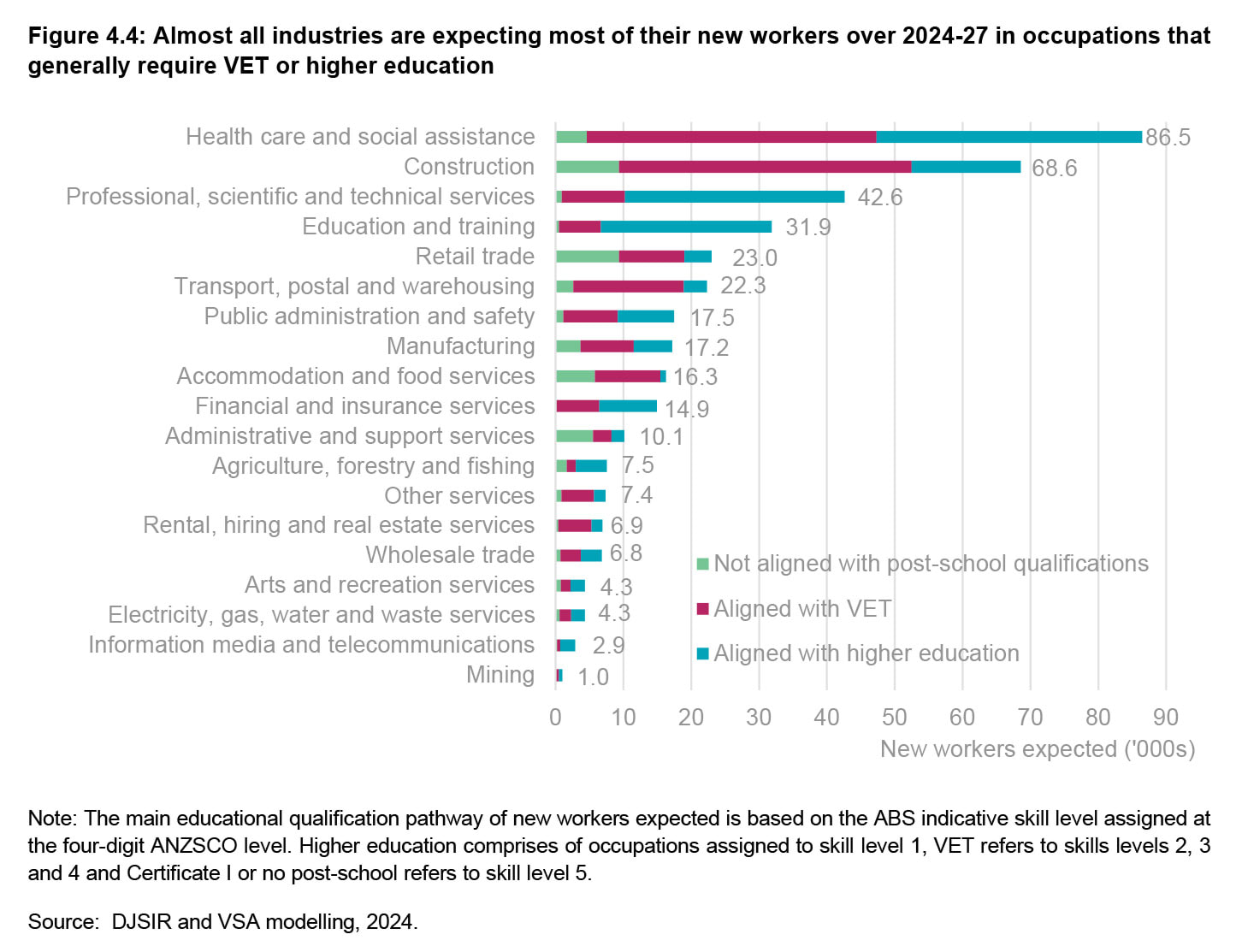Health care and social assistance is expected to have the highest growth in new workers, increasing by 86,500 over the next three years (2024-27) and 335,000 over the next 10 years (2024-34). It represents almost a quarter of growth in new workers across all Victorian industries. The surge in the health care and social assistance workforce is not unique to Victoria and is also forecast to dominate growth at the national level.6
The next highest growth industries include:
- Construction
- 68,600 new workers expected over 2024-27; and
- 162,900 new workers expected over 2024-34.
- Professional, scientific and technical services
- 42,600 new workers expected over the 2024-27; and
- 141,000 new workers expected over 2024-34.
- Education and training
- 31,900 new workers expected over 2024-27; and
- 129,800 new workers expected over 2024-34.
The top four industries account for most of the new workers expected over the next three to 10 years, 59 per cent and 54 per cent, respectively.
The influences on employment growth vary across industry. Continued government spending is expected to support employment growth in health care and social assistance and education and training, through initiatives such as the National Disability and Insurance Scheme (NDIS) and the Best Start, Best Life reforms.
In particular, the Best Start, Best Life reforms are expected to drive significant additional demand for teachers and educators across the state as Three-Year-Old Kinder and Pre-Prep are rolled out.7
Significant funding from the Commonwealth Government into the aged care sector in response to the Royal Commission into Aged Care Quality and Safety, including funding to support modern award minimum wage increases by the Fair Work Commission of up to 28.5 per cent for direct care employees and other workers, will help attract and retain the aged care workforce.8
The 2024/25 Victorian Budget also includes a record $13 billion to support hospitals and other health services, and upgrade health care facilities.9
Investment in residential construction is expected to increase considerably and lead to significant demand for workers in construction and related industries in order to deliver on the objectives of the Housing Statement. Victoria’s Big Build and other public infrastructure projects also mean that construction activity and demand for workers will remain elevated for some time.
Growth across all other Victorian industries is expected to be positive. The professional, scientific and technical services industry is expected to grow above average, continuing a trend towards an increasingly knowledge-driven and professional workforce. Software and applications programmers, ICT managers and other ICT-related roles in the industry are expected to have strong growth to help service the digital transformation of the economy. Civil engineering professionals; and architects and landscape architects are also contributing to industry growth to service the needs of the construction sector.
Retail trade, which is Victoria’s fourth largest industry, is also expecting a high number of new workers to replace those that retire, particularly over the next 10 years. However, excluding retirements, employment growth is anticipated to be slightly below average as retailers become more automated and as customers move increasingly towards online shopping.
Out of the 19 industries, 10 have higher education as the most common primary qualification pathway for new workers, and eight have VET as the most common primary pathway.
Over 70 per cent of new workers expected in the transport, postal and warehousing and rental, hiring and real estate services are in occupations that generally require a VET qualification, the highest among the industries.
Construction also has a relatively large share of new workers expected in occupations that generally require VET qualifications at 63 per cent (this includes apprentices). Around half of new workers expected in health care and social assistance will be in VET-aligned occupations.
Table 4.1: Occupations in demand aligned with VET and higher education across selected industries, 2024-27
Table 4.1 shows the top 10 fastest growing industries over 2024-27 and, within each, the top four VET and higher education-aligned occupations that are expected to be in high demand. New workers expected for ageing and disability carers and registered nurses in health care and social assistance greatly exceed other occupations among these selected industries.
| Top 10 industries (2024-27) | Top four occupations (2024-27) | New workers expected (2024-27) |
|---|---|---|
| Health care and social assistance | Ageing and disability carers* | 12,500 |
| Registered nurses | 11,100 | |
| Receptionists* | 4,800 | |
| Nursing support and personal care workers* | 4,100 | |
| Construction | Construction managers | 7,700 |
| Carpenters and joiners* | 6,100 | |
| Electricians* | 4,500 | |
| Plumbers* | 3,500 | |
| Professional, scientific and technical services | Software and applications programmers | 4,100 |
| Accountants | 3,400 | |
| ICT managers | 1,700 | |
| Civil engineering professionals | 1,700 | |
| Education and training | Primary school teachers | 6,500 |
| Secondary school teachers | 5,800 | |
| Education aides* | 2,200 | |
| Private tutors and teachers | 1,900 | |
| Retail trade | Retail managers* | 2,500 |
| Storepersons* | 1,200 | |
| Motor vehicle and vehicle parts salespersons* | 800 | |
| Pharmacists | 600 | |
| Transport, postal and warehousing | Truck drivers* | 3,500 |
| Automobile drivers* | 2,800 | |
| Storepersons* | 1,700 | |
| Delivery drivers* | 1,300 | |
| Public administration and safety | Security officers and guards* | 1,400 |
| Police* | 1,300 | |
| General clerks* | 800 | |
| Inspectors and regulatory officers | 600 | |
| Manufacturing | Production managers | 1,100 |
| Cabinetmakers* | 1,000 | |
| Structural steel and welding trades workers* | 700 | |
| Metal fitters and machinists* | 600 | |
| Accommodation and food services | Waiters* | 1,800 |
| Chefs* | 1,500 | |
| Cafe and restaurant managers* | 1,300 | |
| Bar attendants and baristas* | 1,000 | |
| Financial and insurance services | Financial investment advisers and managers | 1,600 |
| Financial brokers* | 1,300 | |
| Bank workers* | 1,100 | |
| Credit and loans officers* | 800 |
Note: * Designates occupations whose main education and training pathway are aligned with a VET qualification (skill levels 2 to 4). Table only presents the top 10 industries in terms of new workers expected in 2024-27.
Source: DJSIR and VSA modelling, 2024.
Updated

